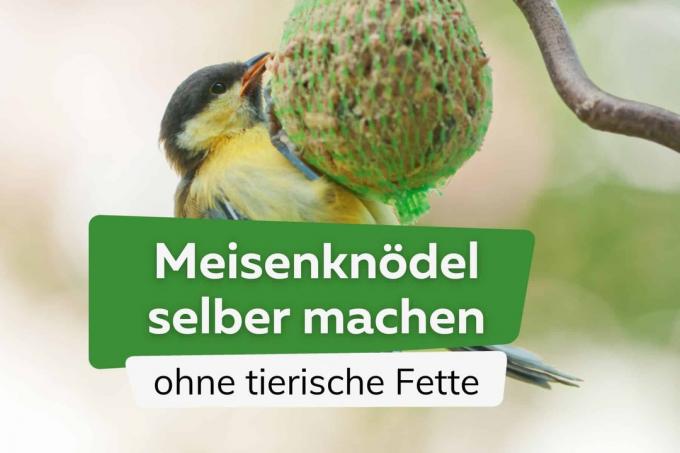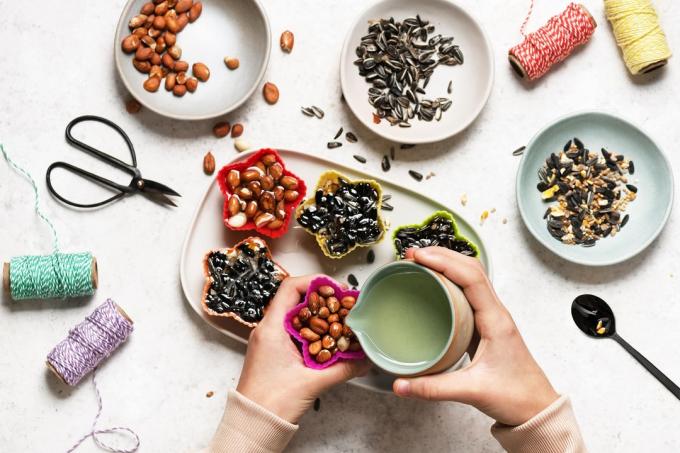
Especially in the cold season, when food is scarce, our wild birds are happy about an additional offer. We will show you how you can make fat balls yourself without the well-known animal fats.
In a nutshell
- Use vegetable fats instead of animal fats
- alternatively, make fat balls from peanut butter
- Ingredients for grain eaters chopped nuts, wheat, sunflower seeds
- Ingredients for soft feed eaters Oatmeal, wheat bran, dried berries
- Mix your own spread feed without fat
Table of contents
- Make fat dumplings yourself
- berries and grains
- Ingredients for soft feed eaters
- Peanut butter for fat balls
- Make other feed mixtures
- grain eater
- Soft feed eater
- Choose vegetable fats
- Instructions for making
- Use other shapes
- feeding bells
- Bake cookies"
- pinecone
- frequently asked Questions
Make fat dumplings yourself
Fat balls are not only very popular with tits. Also other birds like goldfinches, robins or sparrows they like to eat. Usually becomes production of beef or mutton tallow. There is also a vegan way to make fat dumplings yourself without the need for animal fats. The production is not particularly expensive, easy and not very complex. Since not all birds do equally well with grains, several ingredients should come into play. The richer the ingredients, the more different bird species are attracted.
berries and grains
All types of grains, nuts and seeds can be used here, such as:
- shelled or unshelled sunflower seeds
- linseed
- wheat bran
- pumpkin seeds
- hemp seeds
- buckwheat
- millet
- Wheat
- Poppy
- Oat and spelled flakes

In addition, nuts are of course a specialty for many bird species, especially tits. However, these should be crushed before processing. They must be unsalted and unseasoned.
Are very popular:
- peanuts
- walnuts
- hazelnuts
Ingredients for soft feed eaters
These include robin, dunnock, wren, thrush, starling and blackbird. They don't do well with grains, instead loving rather soft ingredients like:
- dried mealworms and shrimp
- raisins
- dried berries such as buckthorn, hawthorn and privet
Peanut butter for fat balls
You can substitute fats for making fat balls with peanut butter. However, this must be natural and should not contain palm oil if possible. The production is simple and quick:
- Slightly warm the peanut butter.
- form dumplings.
- Press the ingredients into the mass.
- Thread balls onto string and hang up.

Make other feed mixtures
You can also easily make your own fat-free feed mixes. In advance, you should carefully monitor which birds regularly visit the feeding place, i.e. whether they mainly eat soft food, grain eaters or omnivores. Then the mixtures are put together.
grain eater
With their powerful beaks, they can easily crack hard shells. These include finch, sparrow, siskin and bullfinch. Such a mixture may contain:
- two thirds of sunflower seeds
- a quarter of hemp seed and further
- smaller seeds
- oatmeal
- Chopped nuts

Soft feed eater
With their more delicate beaks, they are unable to digest hard grains. They love soft ingredients in their food. To do this, the following should be mixed in a 1:1 ratio:
- oatmeal
- raisins
- wheat bran
- berries dried
- Fruit
- dried mealworms
If you are not sure, you can also make a mixture of grains and soft food. There is something for every bird. Omnivores such as tits, nuthatches and woodpeckers also get their money's worth.
Choose vegetable fats
In order to make fat balls yourself without using animal fats, you should choose coconut fat or coconut oil. These vegetable fats are tasteless and odorless and they solidify at low temperatures. To make about six fat balls, use 150 g coconut fat and 150 g seed mixture consisting of:
- sunflower seeds
- hemp
- nuts
- oatmeal
- Wheat
- other seed types

Soft lining mix:
- 150 g coconut fat
- 150 g mixture of wheat bran, oatmeal, raisins, dried berries
- alternatively, grains can be added
A notice: When choosing vegetable fats shouldMake sure that these are not too runny. Otherwise the fat balls can easily melt on warmer winter days and soil the birds' plumage.
Instructions for making
To make fat dumplings yourself without animal fat, only a few steps are necessary:
- Melt fat slowly in a saucepan.
- Do not exceed the melting point, just liquefy.
- Gently stir in the ingredient mixture.
- Allow mixture to cool slightly until fat turns slightly white again.
- form dumplings.
- Leave to harden, if necessary place in the fridge.
The fat dumplings can also be made in advance. Freezing is possible without any problems. They can be stored in a sealed jar in the refrigerator for several weeks.
Use other shapes
This prepared mass can also be presented to the birds in other forms. These are a nice change and are also readily accepted by the birds.
feeding bells

The production is very simple. A clay flower pot is required for this.
- Line a small clay pot with cling film
- Pull a coconut cord (60 cm long) through the drainage hole and foil.
- 15 cm of cord must protrude from the lower end of the pot.
- Pour the prepared mass into a saucepan.
- Coconut cord must stay in the middle
- let the mass harden.
- Then take it out of the pot and remove the foil.
- Decorate the top of the bell with some fir and hang it up.
Alternatively, the pot can also be hung up. Then no lining with foil is necessary. Cups or halved coconut shells or orange peels can also be used for production.
Bake cookies"

- Line the baking sheet with parchment paper.
- Place cookie cutters on top.
- Fill well with the viscous feed mixture and smooth out.
- Insert a wooden skewer into the top of the mold.
- Let the mass harden, remove the mould.
- remove skewer.
- Pull wire or strong twine through the hole to hang it up.
pinecone

It can also self-collected dry and opened Fir and pine cones be prepared as a source of food:
- Attach ribbon to the top end of the pivot for hanging.
- Pour the feed mixture over the cones.
- Alternatively spread several times with a spoon.
- Let harden well and hang up.
A notice: A tablespoon of cooking oil should be added to the melted coconut oil. This makes the fat firm and not brittle.
frequently asked Questions
The nets are made of plastic. The birds can easily get their feet caught in these when eating and get injured. In addition, such networks are not particularly environmentally friendly. Those lying on the ground can also be dangerous for small mammals.
In general, the feed must be dry. Feed silos are well suited. In addition, the space should be clear and offer protection from cats. It is optimal in the vicinity of trees and hedges that offer protection. If the feed is put out in a bird feeder, it must be cleaned regularly with warm water. Straw feed can also be spread on wooden discs or boards on the ground. However, these should not be left there overnight as they attract rats.
Especially in the winter months, the wild birds need a lot of energy to defy the cold temperatures. Here they gladly accept an additional offer of food. Feeding should be done from November to the end of February. Fresh drinking water must also be provided.
Under no circumstances should leftovers be offered. Salty bacon and boiled potatoes are also not suitable food. Bread should also be avoided at all costs, as it swells in the birds' stomachs.



